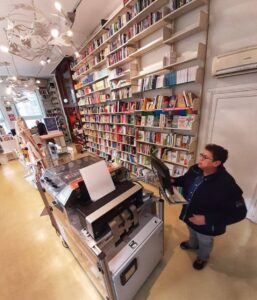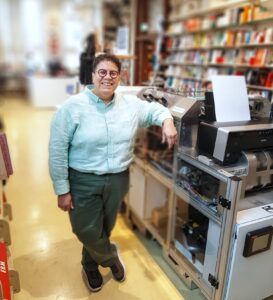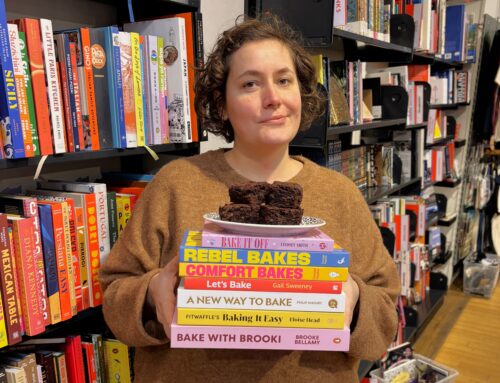Written by Lynn
After stalking the owners of a prototype Espresso Book Machine (EBM) for several years until a new version was launched for use in bookstores and libraries in 2008, I traveled to London and to Cambridge, MA to see how it worked and to make a business case for purchasing one. One of the main concerns was who would be able to do maintenance on this side of the ocean. Another concern was cost. Avo and I invested our pension money in two machines, wanting the two stores to have equal facilities and thinking that the Royal Library in the Hague would be as good a source of clients as the Harvard Book Store’s EBM enjoyed from their world-famous archive next door. Another source of content would be Project Gutenberg, where copies of all known books are digitized and made available to the public. A world of books, all to be available in our stores – without air freight or custom delays, books could be made on the spot in the time it takes to drink an Espresso coffee. It was risky. And very promising.
The Royal Library stream never happened despite 5 attempts, customers didn’t have the imagination to print newly digitized old books and publishers did not give licenses to print their backstock titles as expected. What had we expected? I thought within three years there would be Espresso Book Machines on every corner like the One Hour Photo Studios that popped up in the ‘90s. Will there ever be a bookmaking machine connected to a sort of Spotify or iTunes for books? I expect so. We were just too early.
 Meanwhile back in 2010, it was a job to inform and encourage enough staff members, OR and tech staff to be able to run the machine gladly. Several people agreed to be trained to make books on the EBM, as it was then called. Only one, philosophy buyer María, really took the machine to heart and learned to do its maintenance and repair, Facetiming with the expert John in America when needed. We launched the machine on Thanksgiving 2010, with initiator and publishing luminary Jason Epstein in the store.
Meanwhile back in 2010, it was a job to inform and encourage enough staff members, OR and tech staff to be able to run the machine gladly. Several people agreed to be trained to make books on the EBM, as it was then called. Only one, philosophy buyer María, really took the machine to heart and learned to do its maintenance and repair, Facetiming with the expert John in America when needed. We launched the machine on Thanksgiving 2010, with initiator and publishing luminary Jason Epstein in the store.
Authors did embrace the machine, guided mainly by María and Lília. Steven set us up as a publishing imprint Any Book Press which can issue ISBNs. More than 300 authors did choose this so that they could sell their books anywhere via our website. As soon as an order came in, it was printed, copy by copy.
More machines were sold all over the world, and Maria became the sole EBM mechanic for all the machines in Europe. When France bought six machines for a graphics institute, Maria learned French to be able to install and manage the machines. Ireland and Italy followed (but she already knew those languages).
 Bit by bit, though, the machines went into disuse. Then the licensing company lost its rights, leaving us last year with only self-published books to print. The demand was too low to sustain the program, so we cranked up a Writers’ Night concept to bring authors and other book makers into contact with each other and with Betty the Book Machine, as it had been renamed. Still… it’s just not enough. We’re faced with rising costs and lesser sales compared with the past two years, and the machine parts are showing wear.
Bit by bit, though, the machines went into disuse. Then the licensing company lost its rights, leaving us last year with only self-published books to print. The demand was too low to sustain the program, so we cranked up a Writers’ Night concept to bring authors and other book makers into contact with each other and with Betty the Book Machine, as it had been renamed. Still… it’s just not enough. We’re faced with rising costs and lesser sales compared with the past two years, and the machine parts are showing wear.
So, 15 years after our EBM launch on Thanksgiving Day 2010, we will have a farewell party for Betty on Wednesday 3 December, 2025. María will print book orders until the end of January, first come first served, then she and Betty will take their leave. Sad but grateful for the adventure this project has brought, and the happy tears of writers seeing their dreams come rolling down the chute, it’s time to close. Other options are now available for writers, and we’ll still try to inform them.
Winding down is also a work in progress – your support and empathy are appreciated. It’s been a long and winding road towards the future of making ideas available physically to all. We’ve made first steps and can look back with fondness and pride.





